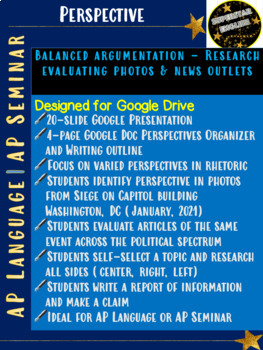Perspectives - Photos & AllSides.com - Identifying Bias AP Language AP Seminar
- Google Drive™ folder
- Internet Activities

Description
Help students understand perspective and bias in photos and news using images and news reports/editorials from the Siege on the Capitol, Washington, D.C. January 2021
Perspective is a key term and concept in both the AP Language and AP Seminar courses. Strong rhetoric requires students to examine an issue from multiple perspective and points-of-view. When students engage with "multiple voices in the conversation" on any topic or issue, they are not only well-informed, but poised to create a researched, informed argument of their own.
Included in this product designed for Google Drive:
- 20-page Slides that includes an introduction to the concept of perspective, 5 photos for analysis, step-by-step directions for activity.
- 4-page Perspectives Docs Organizer and Writing Outline
This activity begins with guided whole-class work identifying perspectives in photos, then moves on to work that can be done in small groups, with partners, independently, or in stations.
Students are asked to:
- Identify "angles" or perspectives of varied photos from January 2021.
- Defend why the perspectives are present.
- Discuss what the perspectives say about intended audience.
- Familiarize with AllSides.com, which offers a range of news and editorial pieces from across the political spectrum (left, right, center).
- Identify keywords in sample headlines from news and editorial pieces across the political spectrum (left, right, center).
- Discuss what keywords say about bias and message to an intended audience.
- Choose a topic of interest from AllSides.com to further research.
- Gather background information about that topic and summarize the topic in their own words.
- Read and annotate a news or editorial piece about that topic from each point on the political spectrum.
- Evaluate each piece.
- Write a report of information (can be a great launching point for the AP Seminar IRR or the AP Language Synthesis Essay)
- Formulate a claim that demonstrates their own opinion on the topic.
- Consider how editorial bias influenced their position.
For related activities, please peruse these products from my store:
Intro to the Rhetorical Situation
MineCraft a Synthesis Essay (Original Prompt)


